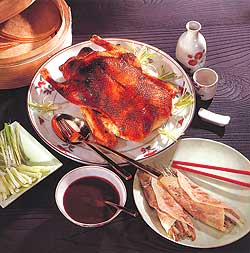 I have always held firm to the view that in the distant land that is Baneswor, one can, without difficulty, meander from end to end without ever stimulating a solitary taste bud. So one Saturday, while dipping into my favourite expat magazine, ECS, there I found, nestling up to an intriguing article on bead collecting, a review of the Beijing Duck Restaurant, located in New Baneswor on the side of the International Conference Centre. Such was the article's lavish and oozing praise for the restaurant, Bhatmara Bhai decided to risk the river crossing.
I have always held firm to the view that in the distant land that is Baneswor, one can, without difficulty, meander from end to end without ever stimulating a solitary taste bud. So one Saturday, while dipping into my favourite expat magazine, ECS, there I found, nestling up to an intriguing article on bead collecting, a review of the Beijing Duck Restaurant, located in New Baneswor on the side of the International Conference Centre. Such was the article's lavish and oozing praise for the restaurant, Bhatmara Bhai decided to risk the river crossing. The restaurant, though on a poorly lit street, is hard to miss with a large gaudy red sign facilitating a safe mooring. This theme is continued in the d?cor choices inside. All is well thought through: draughty, overlit, impersonal and a large room rather adventurously bedecked in red lanterns and Chinese calligraphy. The owner has sought and achieved that classic icon: the 1970s Chinese restaurant look, familiar to Chinese restaurant goers worldwide. Nothing is spared in the detail, from the red wall-to- wall carpeting, right down to the large television that sits in the corner enthusiastically pumping out pop music that competes for ear space with the Chinese elevator music of the restaurant's sound system.
My partner for the evening, a delicious vegetarian, opted for the recommendations of the waiters: a well executed deep fried tofu in sweet chilli sauce that, if eaten as it hits the table, combines the Chinese culinary ideal of contrast, in this case, crunchy and goopy at the same time. The mushroom with coriander, another Chinese classic, in theory, strives for that same ideal. The platter that arrived under Bhatmara Bhai's gaze played a strong suit in sloppy ying but foolishly discarded crunchy yang. Messy.
Bhatmara Bhai went for the signature dish of the restaurant: The Duck. The menu, and indeed the review that stimulated this whole adventure, went into elaborate detail, labouring over the minutiae of the preparation and proper serving of this classic Chinese dish. The theory starts with air being pumped between a duck's skin and flesh. The duck is then scalded repeatedly with boiling water and then coated with a honey mixture and hung until the skin is dry and hard. After the duck is roasted the skin becomes golden and intensely crisp. While hot, the skin is served with thin pancakes and steamed buns, accompanied by spring onions, cucumber and hoisin sauce. The meat is considered a dull secondary attraction and is usually served after the skin.
Mystifyingly, the end result placed before Bhatmara Bhai suggested that the scripture on the menu was taken by the denizens of the kitchen-perhaps a little in the manner of the relationship between car and traffic light in the greater Kathmandu area-merely as gentle guidance. The cook clearly had strong ideas: perhaps an attempt at a more innovative interpretation, an interpretation that didn't work. The duck was closing on cold and dry. The skin rather than crisp, was inexplicably, but not unpleasantly, soft. The meat that should have been removed, for that traditional second course (which never materialised), remained firmly wedded to the skin.
The final twist was the decision of the cook to opt for a rustic hand torn look rather than the thin precise slicing normally favoured by the orthodox. The result, a very small, very nouvelle cuisine sized Rs 3,200 duck. At prices that match London, Bhatmara Bhai did feel justified in inquiring after the reasons for this schismatic interpretation. Apologies were readily proffered and, to be fair, a substantial discount offered. The supply of duck, it turned out, flown from China for that evening had run out and a number of skinnier Nepali ducks had found themselves the victims of this Himalayan Rim neo-Beijing treatment.
However, in fairness, Bhatmara Bhai has been assured by others that have dared the wilds of Baneswor that Chinese duck has been served (and indeed its greater fat content improves the eating experience), even if the manner of serving steers firmly away from the description in the menu. The process of making Beijing duck is extremely time consuming (at least some 24 hours), and for success, requires the guarantee of a large turnover, which in these troubled times and the restaurants locale, presents significant obstacles to perfection. So, if compromise is your thing and the edible river life of the Bagmati, rather than that of Beijing, is acceptable, then come on down to Baneswor!
Starting with this issue, Nepali Times begins a fortnightly restaurant review by Bhatmara Bhai, which is the pseudonym of a Kathmandu-based culinary nomad. -Editor


